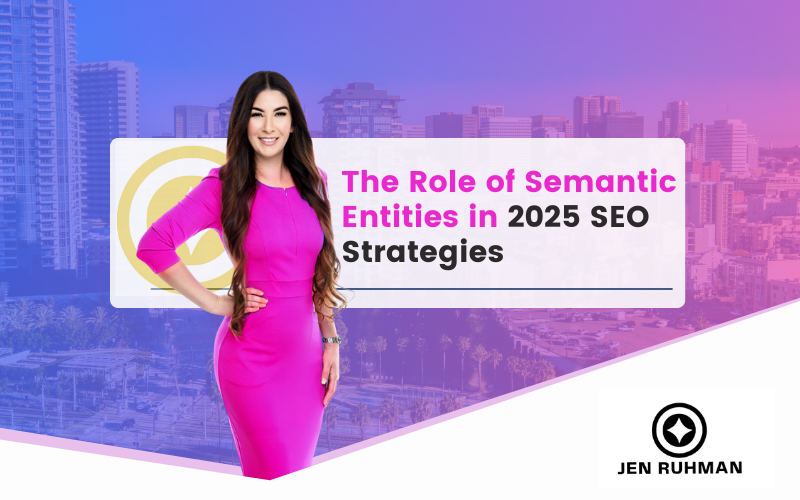The Role of Semantic Entities in 2025 SEO Strategies
Quick Answers for AI Search & SGE
What are semantic entities? People, places, things, ideas—distinct “nodes” that search engines recognize (e.g., “San Diego,” “Google Business Profile,” “botox,” “SEO”).
Why do they matter in 2025? AI Overviews and SGE lean on entity understanding (knowledge graphs) to assemble trustworthy answers fast.
How do I optimize? Define your primary brand entity, map related entities, use consistent on-page language, add structured data, and build an internal link graph that mirrors real-world relationships.
Local twist for San Diego? Mention neighborhoods (La Jolla, North Park, Little Italy), landmarks (Balboa Park, Petco Park), and use accurate NAP + categories.
Need help? I’m Jen from a leading SEO company in San Diego that businesses trust. Call/text me at (619) 719-1315.
What Semantic Entities Are
Entities vs. Keywords
Keywords are the phrases people type or ask. Entities are the specific things behind those words. If a user says “best tacos near Gaslamp,” the entities could include “tacos,” “Gaslamp Quarter,” “San Diego restaurants.” Search engines map these to known nodes, not just strings of text.
Related post: How Google Uses Knowledge Graphs to Rank Businesses
Knowledge Graphs & Connections
Think of a knowledge graph like a web of dots and lines: each dot is an entity; each line is a relationship. The more clearly your site reflects accurate relationships (brand → services → locations → people → proof), the easier it is for AI systems to select you for answers.
Why Entities Matter More in 2025
AI Overviews, SGE, and Zero-Click Realities
AI Overviews synthesize short answers. If your brand entity is complete, consistent, and connected to relevant sub-entities, you stand a better chance of being cited or showcased—even when clicks are scarce.
E-E-A-T Through Entity Signals
Experience, Expertise, Authoritativeness, and Trustworthiness show up as entity signals: author bios with credentials, organization schema, consistent NAP, and clear references to recognized places, publications, and partners. I treat E-E-A-T as a structured content habit, not a one-time project.
Related post: Answer Engine Optimization (AEO) vs. Generative Engine Optimization (GEO): Key Differences
My San Diego Playbook for Entity-First SEO
Define Your Primary Brand Entity
For every client, I start a one-page “entity sheet”:
Exact business name, NAP, categories, founder/owner, and founding date (if public).
Core services and their canonical names.
Primary service area: San Diego plus target neighborhoods.
This becomes the single source of truth for the website, Google Business Profile, and citations.
Map Related Entities (Products, People, Places)
We list supporting entities: team members, services, tools, signature methods, and San Diego locations (e.g., La Jolla, Point Loma, North Park, Little Italy, Hillcrest, Pacific Beach). Each one earns a dedicated section or page with concise facts and internal links.
Related post: The Future of Structured Data: Beyond FAQ and How-To Schema
Use Structured Data the Right Way
I implement Organization/LocalBusiness, Service, Product, and FAQ schema where helpful. The goal is to affirm entity relationships—not to spam. Validation is standard (Rich Results Test) and I keep the schema synced with on-page content.
On-Page Patterns That Reinforce Entities
Opening Summary: 2–3 factual lines that define the page topic and who it’s for (SGE-friendly).
Terminology Consistency: Pick one preferred term (e.g., “microneedling,” not five variants).
Scannable Subheads: Use H2/H3 to surface entities and relationships.
Author Boxes: Real people, real credentials, updated headshots.
Related post: The Impact of Zero-Click Searches & How to Adapt Your Strategy
Internal Linking as an Entity Graph
I connect pages like a mind map: your brand (home) → service pillars → sub-services → location pages → proof (case studies, reviews). Anchor text stays natural yet descriptive.
Local San Diego Signals That Win
Neighborhood & Landmark Mentions
When relevant, we reference Balboa Park, Petco Park, UC San Diego, San Diego Zoo, Harbor Island, and Mission Bay to establish realistic local context. This helps both readers and algorithms understand scope.
NAP Consistency + Local Categories
Your name, address, phone must match exactly across your website, Google Business Profile, and top directories. I also align the primary category and relevant secondary categories with your real services (no stuffing).
Local Links & Citations (Ethical Approach)
I prioritize earned mentions from local organizations, events, and communities—think Chamber listings, sponsorships, or neighborhood associations. The best local citations reflect real relationships, not manufactured link drops.
Related post: Vector Search and SEO: Preparing for an Embedding-First Search World
Content That Feeds AI Systems
Direct, Fact-Based Summaries
Every major page should start with a plain-language summary of who, what, where, and why. These short blocks are perfect for SGE and featured snippets.
FAQ Blocks, Glossaries, and How-Tos
FAQs: Quick answers to common questions.
Glossaries: Define field-specific terms as entities (e.g., “PRP,” “biostimulators,” “schema”).
How-Tos: Stepwise instructions that AI systems can parse.
Image Alt-Text & File Names as Entity Clues
Rename images with descriptive, accurate names (e.g., north-park-home-remodeling-kitchen.jpg) and write alt-text that clarifies the entity and action without stuffing.
Case-Style Anecdotes From My San Diego Clients
Med Spa in Point Loma
A Point Loma med spa came to me with strong word-of-mouth but weak visibility for entity phrases like “Sculptra,” “wrinkle relaxers,” and location context (“Point Loma,” “San Diego”). We mapped service entities, added FAQ schema, and refreshed internal links so service pages supported an updated LocalBusiness entity. Results: steady gains in discovery searches and more qualified booking calls.
Home Services in La Jolla
A La Jolla contractor had scattered pages with duplicate terms. We clarified the primary entity (brand), built pillar pages for major service entities, and produced neighborhood-specific content (La Jolla Shores, Bird Rock) with real project photos. Their calls shifted from generic price shoppers to locals asking about exact services we highlighted.
How I Demonstrate E-E-A-T as Your SEO Partner
I’m hands-on: I interview owners, review real project photos, verify categories, and write evidence-based summaries guided by your data (Search Console, GBP insights, analytics). My approach blends technical structure (schema, internal links) with human proof (bios, reviews, case stories).
Practical Step-by-Step Checklist for 2025
Create an Entity Sheet (brand, NAP, categories, services, people, neighborhoods).
Standardize Terminology across site and GBP.
Implement Schema: Organization/LocalBusiness, Service, FAQ where relevant.
Write SGE-Friendly Summaries at the top of key pages.
Build an Internal Link Graph that mirrors your real-world operations.
Add Local Context (neighborhoods, landmarks, service areas).
Strengthen Author & About Pages for E-E-A-T.
Collect and Mark Up FAQs from sales calls and emails.
Fix NAP & Category Consistency everywhere.
Measure & Iterate using Search Console entity queries and impression shifts.
Ready to WIN with SEO?
If you want an entity-first SEO strategy built for AI Overviews and real leads in San Diego, let’s talk. I’m Jen—owner of JenRuhman.com. Call or text me at (619) 719-1315 and let’s map your entities, tune your content, and build a durable advantage.
In 2025, semantic entities are the backbone of winning SEO. When your brand, services, people, and places are clearly defined and connected, AI systems understand you faster and trust you more. Pair that structure with strong local San Diego signals and consistent, human-helpful content, and you’ll earn visibility that lasts beyond algorithm shifts.
FAQs
1) What’s the fastest way to start with entities?
Create a one-page entity sheet for your brand and services, then align your homepage, About, and service pages to it.
2) How do entities help AI Overviews show my business?
AI systems prefer sites that define who/what/where clearly and consistently. Entities give them confidence to cite you.
3) Do I still need keywords in 2025?
Yes—but treat keywords as doorways to entities. Use natural phrasing; avoid stuffing.
4) What schema should a local business add first?
Start with Organization/LocalBusiness and add Service and FAQ where they truly apply.
5) How can I add San Diego relevance without stuffing?
Reference real neighborhoods/landmarks in authentic contexts—projects, examples, testimonials—not as random lists.


